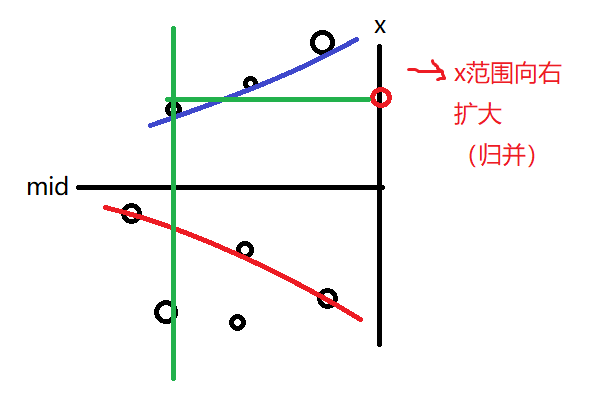BZOJ4237 稻草人Fakeman [CDQ/单调栈]
ri 这题真 tm 难
Problem
JOI 村有一片荒地,上面竖着 N 个稻草人,村民们每年多次在稻草人们的周围举行祭典。
有一次,JOI 村的村长听到了稻草人们的启示,计划在荒地中开垦一片田地。和启示中的一样,田地需要满足以下条件:
田地的形状是边平行于坐标轴的长方形;
左下角和右上角各有一个稻草人;
田地的内部 (不包括边界) 没有稻草人。
给出每个稻草人的坐标,请你求出有多少遵从启示的田地的个数
Solution
先按 y 排序,然后对 x 分治。
很显然对分治出来的两半,左边的点都要在右边的点下面。
我们令上面的点为右上角,计算下面的点对上面的点贡献。
上面的点往后归并的同时,下方维护一个纵坐标递减的单调栈。
为什么要维护单调栈呢?由上图而知,红线下方的点是不能作为左下角的。
而若我们要计算红点的贡献,那么这个矩形能扩到的最左方是第一个纵坐标小于它的点。
如上图绿线所示。
所以我们只要维护上下方的单调栈,并且找出第一个纵坐标小于它的点的横坐标作为限制,对下方的单调栈的横坐标二分查找就行了。
Code
// Code by ajcxsu
// Problem: fakeman
#include<bits/stdc++.h>
using namespace std;
typedef long long ll;
const int N=2e5+10;
struct Node {
int x, y;
} nd[N];
bool operator <(const Node &a, const Node &b) { return a.x<b.x; }
bool cmp(const Node &a, const Node &b) { return a.y<b.y; }
ll tot;
Node ust[N];
Node dst[N];
int ut, dt;
void merge(int l, int r) {
if(l==r) return;
int mid=(l+r)>>1;
merge(l, mid), merge(mid+1, r);
ut=dt=0;
int i=l, j=mid+1;
while(i<=mid && j<=r) {
if(nd[i].x<=nd[j].x) {
while(dt && nd[i].y>dst[dt].y) dt--;
dst[++dt]=nd[i];
i++;
}
else {
while(ut && nd[j].y<ust[ut].y) ut--;
ust[++ut]=nd[j];
tot+=dt-(lower_bound(dst+1, dst+dt+1, ust[ut-1])-dst)+1;
j++;
}
}
while(j<=r) {
while(ut && nd[j].y<ust[ut].y) ut--;
ust[++ut]=nd[j];
tot+=dt-(lower_bound(dst+1, dst+dt+1, ust[ut-1])-dst)+1;
j++;
}
inplace_merge(nd+l, nd+mid+1, nd+r+1);
}
int main() {
int n;
scanf("%d", &n);
for(int i=1;i<=n;i++) scanf("%d%d", &nd[i].x, &nd[i].y);
sort(nd+1, nd+1+n, cmp);
merge(1,n);
printf("%lld\n", tot);
return 0;
}
fakeman
$=CH$